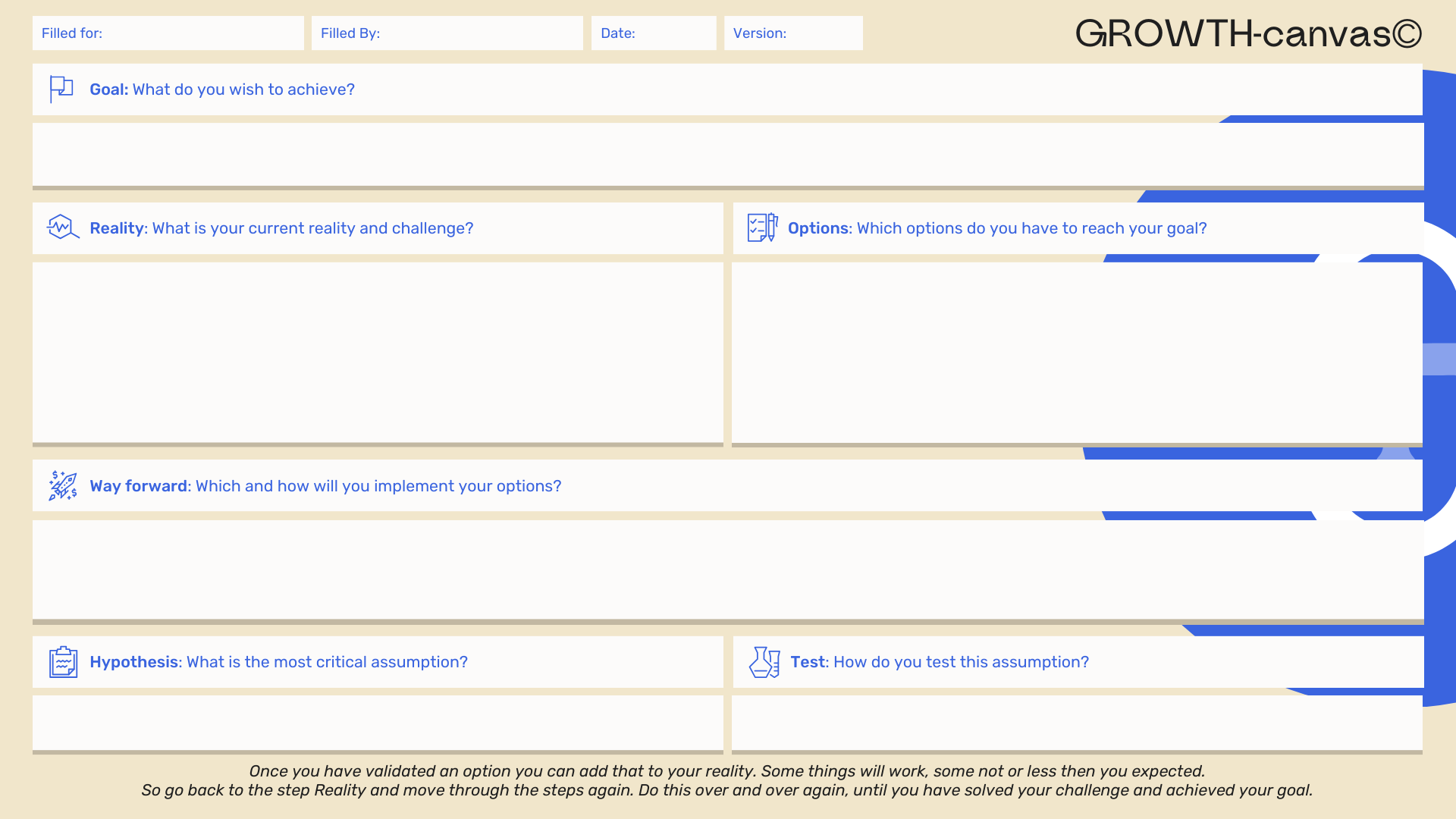The value of implementation
Whether you’re a startup or a large corporation, one of the most critical differentiators between companies that excel and those that stagnate is the MINDSET, SKILLSET and TOOLSET to effectively implement advice and strategies.
While planning is crucial, execution determines results. Organizations often seek advice to fill gaps. However, even the best strategies fail without proper execution. In a rapidly evolving world, effective implementation means being agile, responsive, and ready to adapt. It’s the link between ideas and actual results.
Download the GROWTH-canvas©
Guidelines for implementation
Based on our experience and available evidence we developed an implementation guide that will help you to apply the generated options for any business challenge in your specific context.
The insights captured in our advice, should be approximately right instead of precisely wrong. Insights are worthless without implementation. To improve your rate of success during implementation we are providing you our implementation guidelines and unique GROWTH-CANVAS©. The more thoughtfully you will apply the provided guidelines within the GROWTH-canvas©, the better it will work for you.
Recruit the right team
Select a group of people that you believe collectively have the mindset and skillset to solve your challenge.
- Examples of personality traits (mindset) for an effective team are: curiosity (openness), focus (conscientiousness) and negotiation (agreeableness).
- Expertise (skillset) within the domain to make the right analysis.
- Experience within the organization to build relations and make the right decisions.
- The ideal size seems to be somewhere between 3 and 7 members.
Create the circumstances
- Use a participative approach allowing all stakeholders to contribute.
- Encourage diversity of thinking and constructive disagreement, take all ideas into consideration unless you have evidence against those ideas.
- Observe, then interpretate and postpone your judgement. Listen. Allow people to finish their sentences. Ask clarifying questions to better understand each others point of view.
- Capture the information in a way that helps to reproduce it later.
- Endure. You might need several sessions before you can start with implementation. Take enough time to explore your options as you find your way forward.
Keep in mind that
Your mindset, skillset and toolset are essential for overcoming your business challenge, usually in that order.
MINDSET, your attitude driven by motivation. Motivation is fueled by getting it”; your vision on the future, ‘getting ahead’; your ability to steer towards results and ‘getting along’; your values and the way to engage with your team. The way you think and what you believe matters.SKILLSET, your (exemplary) behavior driven by capabilities. People copy behavior not presentations or excel sheets. The way you act matters.TOOLSET, your (enabling) environment driven by data, processes and technology. Be aware that in isolation a toolset will not solve your problem. It will only scale when driven by the right mindset and skillset.
Apply the GROWTH-canvas©
A canvas is a piece of paper until you start filling it with the right insights. It however forces you to carefully select the information you want to add as it does not allow you to draft endless text. Reduction and selection is an art. DISTINGUISH RELEVANCE FROM NOISE. Take your time. Then the canvas can deliver its value.
Goal
What do you wish to achieve?
Take the organizational challenge as a starting point and try to set a directional goal. Make sure the goal is clear (and provides direction), committed (with sufficient motivation) and challenging (but achievable). The goal might be a result or learning oriented, the latter is usually better when exploring new grounds.
Reality
What is your current reality and challenge?
Then answer the following questions.
- What objective information (the key facts) do we have?
- What subjective information (the key perceptions) do we have?
- What do we consider to be the driving forces that could help us to achieve this goal?
- What are the restraining forces that (could) hinder us to achieve this goal.
Collect and describe the information that is most relevant to your goal. Allow difference. You might disagree on certain parts of the reality. That is information in itself.
Options
Which options do you have to reach your goal?
We instructed AI to think like a business consultant with 20 years’ experience and generate the 10 validated, evidence-based options to address a business challenge. Now dive into the options:
- Validate these options, make sure you have an understanding of what these would look like in the context of your reality and how they will help to achieve your goal.
- Explore what and who is needed to implement these options.
- Ask yourself if there are options that you believe should be added to the list.
- When you all have good (high level) understanding of the options, move to the next step.
Way forward
Which and how will you implement your options?
Which option(s) you believe to be the best to follow-up depends highly on the context of your organization. Therefore, you should look at the options through the lens of your reality:
- Select the options that will have the most impact on your goal with the highest level of certainty given the reality and the least amount of time and effort.
- If an option is not within your circle of influence you can either:
- Break it up into actions which are within your circle of influence
- Start collaborating with people that do have that level of influence.
- Define the first step you can take next week to start with the implementation of your prefered option?
- Define who does what and when.
- Design the follow-up process that you think is feasible and does not meet too many constraints.
- Agree how this shall be executed.
Hypothesis
What is the most critical assumption?
Make sure that when you move forward you are able to define your key assumption. Ask yourself: What needs to be true in order for this option to contribute to the goal we have defined?
Test
How do you test this assumption?
Then make sure you can validate your hypothesis in the most practical but reliable way possible. Did your actions and its outcome contribute and why (not) so?
Next steps
Once you have validated an option you can add that to your reality. Some things will work, some not or less then you expected. So go back to the step Reality and move through the steps again. Do this over and over again, until you have solved your challenge and achieved your goal.
Download GROWTH-canvas©
Critical assumption and test
- Critical assumption: applying this implementation guide will help you solve your business challenge in your specific context.
- Test: Execute the implementation guide and discover if it leads to the expected outcome for your organisation.
We are curious if the implementation guide works for you. If you have any heedback do not hesitate to contact us at welcome@freeconsultancy.com
When we learn together, we grow together.














